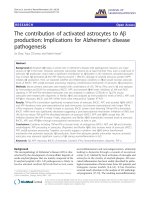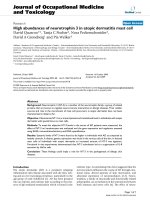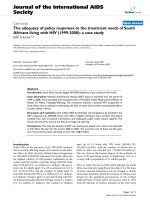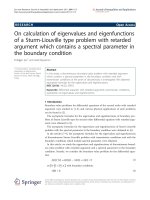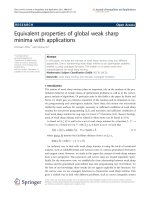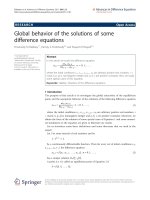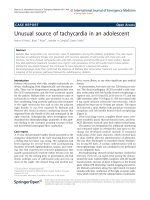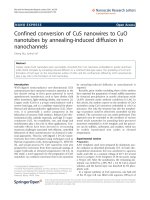Báo cáo hóa học: "BOUNDARY REGULARITY OF WEAK SOLUTIONS TO NONLINEAR ELLIPTIC OBSTACLE PROBLEMS" pdf
Bạn đang xem bản rút gọn của tài liệu. Xem và tải ngay bản đầy đủ của tài liệu tại đây (558.8 KB, 15 trang )
BOUNDARY REGULARITY OF WEAK SOLUTIONS TO
NONLINEAR ELLIPTIC OBSTACLE PROBLEMS
MENG JUNXIA AND CHU YUMING
Received 25 April 2005; Revised 10 Septe mber 2005; Accepted 14 September 2005
We study the boundary regularity of weak solutions to nonlinear obstacle problem with
C
1,β
-obstacle function, and obtain the C
loc
1,α
boundary regularity.
Copyright © 2006 M. Junxia and C. Yuming. This is an open access article distributed
under the Creative Commons Attribution License, which permits unrestricted use, dis-
tribution, and reproduction in any medium, provided the original work is properly cited.
1. Introduction
We consider the following variational inequality:
u
∈:
Ω
A(x, ∇u) · (∇v −∇u)dx
≥
Ω
H(x,u,∇u)(v − u)dx +
Ω
F(x, u) · (∇v −∇u)dx
(1.1)
for all v
∈={v ∈W
1,p
0
(Ω), v≥ψ a.e. in Ω}.HereΩ is a bounded domain in R
N
(N ≥ 2)
with Lipschitz boundary, 2
≤ p ≤ N.
A(x, ξ):Ω
× R
N
→ R
N
satisfies the following conditions:
(i) A is a vector valued function, the mapping x
→ A(x,ξ)ismeasurableforallξ ∈
R
N
, ξ → A(x,ξ)iscontinuousfora.e.x ∈ Ω;
(ii) the homogeneity condition: A(x, tξ)
= t|t|
p−2
A(x, ξ), t ∈ R, t = 0;
(iii) the monotone inequality: (A(x,ξ)
− A(x, ζ))(ξ − ζ) ≥ a|ξ − ζ|
p
;
(iv)
|h||a
ij
| + |∂A
i
(x, h)/∂x
j
|≤τ
1
|h|
p−1
;
(v)
N
i, j
=1
a
ij
ξ
i
ξ
j
≥ τ
2
|h|
p−2
|ξ|
2
;
(vi)
|A(x, ξ) − A(y,ξ)|≤b
1
(1 + |ξ|
p−1
)|x − y|
α
0
;
(vii)
|A(x, ξ) − A(x,η)|≤b
2
||ξ|
p−2
ξ −|η|
p−2
η|;
where a
ij
= ∂A
i
/∂h
j
, a, b
1
, b
2
, τ
1
, τ
2
are positive constants.
Hindawi Publishing Corporation
Boundary Value Problems
Volume 2006, Article ID 72012, Pages 1–15
DOI 10.1155/BVP/2006/72012
2 Boundary regularity
We assume that H(x,u, λ), F(x,u)
={F
i
(x, u)}
1≤i≤N
in (1.1) are of the form:
H(x,u,∇u)
≤
c
|∇
u|
p/r
+ |u|
r−1
+ g(x)
, (1.2)
F(x, u)
≤
c
|
u|
q/p
+ h(x)
, (1.3)
where p<q<r, r
= r/(r − 1), p
= p/(p − 1), and if 2 ≤ p<N, r = Np/(N − p), while if
p
= N,thenr can be some sufficiently large positive number.
Higher regularity of the weak solution to the p-Laplacian obstacle problem
I(u)
= inf
Ω
|∇u|
p
dx : u ∈ K(ψ)
, (1.4)
where
K(ψ)
=
v ∈ W
1,p
(Ω):v ≥ ψ a.e.
, (1.5)
has been studied by various authors. In the case when ψ is assumed to have only minimal
regularity properties, it was shown by [8, 11] that the solution of (1.1)iscontinuous.In
particular, if ψ
∈ C
0,α
(Ω), then the s olution u is also an element of C
0,α
(Ω). In the case
when ψ
∈ C
2
(Ω), papers [4, 6, 10, 12] employed different techniques to prove interior
C
1,α
(Ω) regularity for the solution u to (1.4). Reference [1] gave an interesting result: the
condition for
to be nonempty is just that ψ should have finite capacity. This implies,
among other things, that ψ
+
= max(ψ,0) must vanish on ∂Ω, C—almost everywhere.
This condition is important for the existence of weak solutions to obstacle problem.
When ψ is smooth (say C
1,α
(Ω)), the interior regularity of weak solutions to problem
(1.1) has been studied extensively by many authors ([3, 13, 14]).
In view of De Giorgi class, paper [2]obtainedC
0,α
interior regularity for solutions of
nonlinear elliptic obstacle problem with natural growth in the gradient by taking appro-
priate test function.
The main concern of these papers is the question of the regularity of the solution u
in terms of the given regularity properties of the obstacle ψ and relevant data. This is
especially interesting in view of the fact that there is a limit to the amount of regularity
that u can inherit from ψ: it is possible for ψ to be real analytic, but u w ill be at best C
1,1
,
that is, have bounded second derivatives.
This paper obtains C
1,α
loc
boundary regularity of weak solutions to the obstacle problem
with C
1,β
-obstacle function under controllable growth condition (1.2). We present a new
proof to a useful comparison principle.
2. Notations and preliminaries
Ω is an open bounded subset of R
N
, N ≥ 2; ∂Ω is the b oundary of Ω.Ifz ∈ R
N
,weput
B
R
(z) =
x ∈ R
N
: |x − z| <R
, Γ
R
(z) =
x ∈ B
R
(z):x
n
= 0
,
B
+
R
(z) =
x ∈ B
R
(z):x
n
> 0
, B
−
R
(z) =
x ∈ B
R
(z):x
n
< 0
.
(2.1)
We denote by B, B
+
, B
−
, Γ, respectively, B
1
(0), B
+
1
(0), B
−
1
(0), Γ
1
(0). For ever y set E we
denote by
¯
E its closure, and by
|E| its Lebesgue measure. ( f )
R
= (1/|B
R
|)
B
R
f (x)dx.The
M. Junxia and C. Yuming 3
letter c is used throughout to denote a positive constant, not necessarily the same at each
occurrence.
Since
Ω is compact, ∂Ω can be covered by a finite number of neighbourhoods V of its
points. It is enough to prove the better regularity of u holds true in V
∩ Ω.Since∂Ω is a
Lipschitz boundary, one can find T which is an invertible Lipschitz mapping such that
T(V)
= B, T(V ∩ Ω) = B
+
, T(V\Ω) = B
−
, T(V ∩ ∂Ω) = Γ. (2.2)
Under the mapping T the variational inequality in Ω is transfor med to a variational
inequality of the same form in B
+
,for
¯
u = u ◦ T
−1
which satisfies
B
+
¯
A(x,
∇
¯
u)
· (∇v −∇
¯
u)dx
≥
B
+
¯
H(x,
¯
u,
∇
¯
u)(v
−
¯
u)dx +
B
+
¯
F(x,
¯
u)
· (∇v −∇
¯
u)dx,
∀v ∈
¯
,
(2.3)
where
¯
={v ∈ W
1,p
0
(B
+
), v ≥ ψ,a.e.inB
+
},
¯
A,
¯
H,
¯
F satisfy assumptions of type (i)–
(vii), (1.2), (1.3)withdifferent constants.
In order to simplify the notations, we still denote
¯
u,
¯
¯
A,
¯
H,
¯
F by u,
, A, H, F,re-
spectively.
Since the original u
∈ W
1,p
0
(Ω), we define then
u(x):
=
⎧
⎪
⎨
⎪
⎩
u(x), if x ∈ B
+
,
−3u
x
1
, ,x
n−1
,−x
n
+4u
x
1
, ,x
n−1
,−
x
n
2
,ifx ∈ B
−
.
(2.4)
In light of Extension theorem [5, page 254], we only need to prove a better regularity of
u in B
+
.
Definit ion 2.1. The function u
∈that satisfies (2.3)forallv ∈is called a weak solu-
tion to the obstacle problem with obstacle ψ.
Definit ion 2.2. Call f
∈ C
0,α
(Γ), if for all x ∈ Γ, there exists B
r
(x)(aballcenteredatx of
radius r), r>0, such that f
∈ C
0,α
(B
r
(x)).
In the sequel, we will abbreviate B
+
∩ B
R
(y
0
) = B
+
R
, B
+
∩ B
ρ
(y
0
) = B
+
ρ
,for0<ρ<R≤
1, the point y
0
∈ Γ to be understood.
In the following, we will use some lemmas which we state below.
Lemma 2.3. Let w
∈ W
1,p
(B
+
R
) beasolutionoftheDirichletproblem
B
+
R
A(x, ∇w)∇φdx= 0 ∀φ ∈ W
1,p
0
B
+
R
,
w
− u ∈ W
1,p
0
B
+
R
.
(2.5)
4 Boundary regularity
For 0 <ρ<R/2, σ
∈ (0, 1),
B
+
R
|∇w|
p
dx ≤ c
B
+
R
|∇u|
p
dx, (2.6)
B
+
ρ
|∇w|
p
dx ≤ c
ρ
R
N
B
+
R
|∇w|
p
dx, (2.7)
B
+
ρ
∇
w − (∇w)
ρ
p
dx ≤ c
ρ
R
N+σ
B
+
R
∇
w − (∇w)
R
p
dx. (2.8)
Proof. We can easily get (2.6) by inserting φ
= w − u in (2.5).
An argument similar to the one in [15, Lemma 2.2] shows that (2.7)hold.
The proof of (2.8) is similar to that of [9, Theorem 1.7].
Lemma 2.4. Let v ∈ W
1,p
(B
+
R
) beasolutionoftheDirichletproblem
B
+
R
A(x, ∇v)∇φdx=
B
+
R
A(x, ∇ψ)∇φdx,
w
− v ∈ W
1,p
0
B
+
R
, ∀φ ∈ W
1,p
0
B
+
R
,
(2.9)
then
B
+
R
|∇w|
p
dx ≤ c
B
+
R
|∇v|
p
dx, (2.10)
B
+
R
|∇v −∇w|
p
dx ≤ c
B
+
R
|∇ψ|
p
dx. (2.11)
Proof. Formula (2.10) fol lows immediately from taking φ
= w − v in (2.5).
Inserting φ
= v − w in (2.5)and(2.9), by monotone inequality (iii) and H
¨
older’s in-
equality, we have
B
+
R
|∇v −∇w|
p
dx ≤ c
B
+
R
A(x, ∇v) − A(x,∇w)
·
(∇v −∇w)dx
= c
B
+
R
A(x, ∇ψ) · (∇v −∇w)dx
≤ c
B
+
R
|∇ψ|
p−1
|∇v −∇w|dx
≤ c
B
+
R
|∇ψ|
p
dx
(p−1)/p
B
+
R
|∇v −∇w|
p
dx
1/p
(2.12)
from which we get (2.11).
Lemma 2.5. If v ∈ W
1,p
(B
+
R
) is a solution of the D irichlet problem (2.9), then v ≥ ψ in B
+
R
.
Proof. It follows from v
= u on ∂B
+
R
, u ∈,thatv ≥ ψ on ∂B
+
R
.Letξ = min(v,ψ), ξ = ψ
on ∂B
+
R
, ξ − ψ ∈ W
1,p
0
(B
+
R
). As test functions in (2.9)wetakeφ = ξ − ψ,from(2.9)and
M. Junxia and C. Yuming 5
monotony inequality (iii), we have
0
=
B
+
R
A(x, ∇v) − A(x,∇ψ) ·∇(ξ − ψ)dx
=
B
+
R
{
x,v(x)≤ψ(x)}
A(x, ∇v) − A(x,∇ψ) ·∇(v − ψ)dx
≥ a
B
+
R
{
x,v(x)≤ψ(x)}
|∇v −∇ψ|
p
dx
= a
B
+
R
|∇ξ −∇ψ|
p
dx
(2.13)
therefore ξ
= ψ a.e. in B
+
R
, that is, v ≥ ψ a.e. in B
+
R
.
This lemma is a useful comparison principle, it can be used to obtain the existence or
regularity of solutions to elliptic equation or variational inequalit y.
We ex tend v to B
+
by setting v = u on B
+
\B
+
R
, and hence v ∈. We have t he following
corollary.
Corollary 2.6. Suppose u is a weak solution to the obstacle problem (2.3), v
∈ W
1,p
(B
+
R
)
is a solution of the D irichlet problem (2.9), then v
∈satisfies the variational inequality
B
+
A(x, ∇u) · (∇v −∇u)dx ≥
B
+
H(x,u,∇u)(v − u)dx +
B
+
F(x, u) · (∇v −∇u)dx.
(2.14)
Lemma 2.7. Assume u is a weak solution to the obstacle problem (2.3), where H, F verify
(1.2), (1.3), respectively, g
∈ L
t
(B
+
) with t>N/p, h ∈ L
s
(B
+
) with s>p
, v satisfies (2.9),
then
B
+
R
|∇v|
p
dx ≤ c
B
+
R
|∇u|
p
dx +
B
+
R
|∇ψ|
p
dx
, (2.15)
B
+
R
|∇u −∇v|
p
dx ≤ c
B
+
R
|∇
u|
p
+ |u|
r
dx
1+δ
+
B
+
R
|∇u|
p
dx
q/p
+
B
+
R
|u|
r
dx
q/p
+ R
Np(1−1/r−1/t)/(p−1)
+ R
N(1− p
/s)
+ R
N(1− p/m)
,
(2.16)
where δ
= (r − p)/r(p − 1) > 0.
Proof. By inserting φ
= v − u in (2.9), an application of H
¨
older’s inequality and Young’s
inequality y ields
B
+
R
|∇v|
p
dx ≤ c
B
+
R
A(x, ∇v) ·∇vdx
= c
B
+
R
A(x, ∇v) ·∇udx+
B
+
R
A(x, ∇ψ) ·∇(v − u)dx
6 Boundary regularity
≤ c
B
+
R
|∇v|
p−1
|∇u|dx +
B
+
R
|∇ψ|
p−1
|∇u −∇v|dx
≤
c
B
+
R
|∇v|
p
dx
(p−1)/p
B
+
R
|∇u|
p
dx
1/p
+
B
+
R
|∇ψ|
p
dx
(p−1)/p
B
+
R
|∇u −∇v|
p
dx
1/p
≤
c
1
B
+
R
|∇v|
p
dx + c
1
, p
B
+
R
|∇u|
p
dx + c
2
B
+
R
|∇u −∇v|
p
dx
+ c
2
, p
B
+
R
|∇ψ|
p
dx
≤
c
1
+ c
2
B
+
R
|∇v|
p
dx +
c
1
, p
+ c
2
B
+
R
|∇u|
p
dx
+ c
2
, p
B
+
R
|∇ψ|
p
dx
(2.17)
for (c
1
+ c
2
)sufficiently small (c
1
+ c
2
< 1), we can get (2.15).
By ψ ∈ W
1,m
(Ω), m>N,wehave
B
R
|∇ψ|
p
dx ≤ c∇ψ
p
m
R
N(1− p/m)
. (2.18)
Combining monotone inequality (iii), (2.9), (2.14), and (1.2) and using Poincare’s
inequality, H
¨
older’s inequality, we have
B
+
R
|∇u −∇v|
p
dx
≤ c
B
+
R
A(x, ∇u) − A(x, ∇v)
·
(∇u −∇v)dx
≤ c
B
+
R
H(x,u,∇u)(u− v)+
F(x, u) − A(x, ∇ψ)
·
(∇u −∇v)
dx
≤ c
B
+
R
|∇
u|
p(1−1/r)
+ |u|
r−1
+ |g|
|u − v|dx
+ c
B
+
R
|
u|
q/p
+ h(x)
|∇
u −∇v|dx + c
B
+
R
|∇ψ|
p−1
·|∇u −∇v|dx
≤ c
B
+
R
|∇
u|
p
+ |u|
r
+ |g|
r/(r−1)
dx
1−1/r
B
+
R
|u − v|
r
dx
1/r
+
B
+
R
|
u|
q
+ |h|
p
dx
1/p
B
+
R
|∇u −∇v|
p
dx
1/p
+
B
+
R
|∇ψ|
p−1
·|∇u −∇v|dx
M. Junxia and C. Yuming 7
≤ c
B
+
R
|∇
u|
p
+ |u|
r
dx
1−1/r
+ g
t
R
N(1−1/r−1/t)
×
R
1−N(1/p−1/r)
B
+
R
|∇u −∇v|
p
dx
1/p
+ c
B
+
R
|
u|
p
+ |∇u|
p
dx
q/pp
+ h
s
R
N(1/p
−1/s)
+
|∇
ψ|
p−1
p/(p−1)
×
B
+
R
|∇u −∇v|
p
dx
1/p
(2.19)
since 0 <R
≤ 1, by (2.18), H
¨
older inequality, Young inequality, we have
B
+
R
|∇u −∇v|
p
dx
≤ c
B
+
R
|∇
u|
p
+ |u|
r
dx
1+δ
+
B
+
R
|∇u|
p
dx
q/p
+
B
+
R
|u|
p
dx
q/p
+ g
p/(p−1)
t
R
Np(1−1/r−1/t)/(p−1)
+ h
p/(p−1)
s
R
N(1− p
/s)
+
B
+
R
|∇ψ|
p
dx
≤
c
B
+
R
|∇
u|
p
+ |u|
r
dx
1+δ
+
B
+
R
|∇u|
p
dx
q/p
+
B
+
R
|u|
p
dx
q/p
+ R
Np(1−1/r−1/t)/(p−1)
+ R
N(1− p
/s)
+ R
N(1− p/m)
≤
c
B
+
R
|∇
u|
p
+ |u|
r
dx
1+δ
+
B
+
R
|∇u|
p
dx
q/p
+
B
+
R
|u|
r
dx
q/r
B
R
(q/p)(1−p/r)
+ R
Np(1−1/r−1/t)/(p−1)
+ R
N(1− p
/s)
+ R
N(1− p/m)
≤
c
B
+
R
|∇
u|
p
+ |u|
r
dx
1+δ
+
B
+
R
|∇u|
p
dx
q/p
+
B
+
R
|u|
r
dx
q/p
+ R
N(q/p)
+ R
Np(1−1/r−1/t)/(p−1)
+ R
N(1− p
/s)
+ R
N(1− p/m)
≤
c
B
+
R
|∇
u|
p
+ |u|
r
dx
1+δ
+
B
+
R
|∇u|
p
dx
q/p
+
B
+
R
|u|
r
dx
q/p
+ R
Np(1−1/r−1/t)/(p−1)
+ R
N(1− p
/s)
+ R
N(1− p/m)
(2.20)
which implies (2.16).
8 Boundary regularity
3. C
0,λ
regularity
Theorem 3.1. Assume that H(x, u,
∇u) satisfies (1.2), g ∈ L
t
(B
+
) with t>N/p, F(x, u)
satisfies (1.3), h
∈ L
s
(B
+
) with s>N/(p − 1),andψ ∈ W
1,m
(B
+
) with m>N.Ifu ∈
makes (2.3)hold,thenu ∈ C
0,λ
(Γ) with λ = min{1 − N(1/t +1/r − 1/p)/(p − 1),1 − N/
s(p
− 1),1 − N/m}.
Before proceeding with the formal proof, we make an impor tant observation. It is a
well-known result.
Proposition 3.2. If f
∈ W
1,p
(Ω), then for all constants k ∈ R
N
,
B
ρ
∇
f − (∇ f )
ρ,x
0
p
dx ≤ C(p)
B
ρ
|∇ f − k|
p
dx (3.1)
for every ρ for which B
ρ
(x
0
) ⊂ Ω.
Proof. By elementary inequality, we have
B
ρ
∇
f − (∇ f )
ρ,x
0
p
dx ≤ C(p)
B
ρ
|∇ f − k|
p
dx +
B
ρ
k − (∇ f )
ρ,x
0
p
dx
. (3.2)
Moreover
B
ρ
k − (∇ f )
ρ,x
0
p
dx =
B
ρ
k − (∇ f )
ρ,x
0
p
=
B
ρ
k −
1
B
ρ
B
ρ
∇ fdx
p
=
B
ρ
1
B
ρ
B
ρ
(k −∇f )dx
p
=
B
ρ
1−p
B
ρ
(k −∇f )dx
p
≤
B
ρ
1−p
B
ρ
|∇ f − k|
p
dx
B
ρ
p(1−1/p)
=
B
ρ
|∇ f − k|
p
dx.
(3.3)
Therefore (3.1)holdsforanyk
∈ R
N
.
Proof of Theorem 3.1. To get the regularity, we need to prove the following inequality:
B
+
ρ
|∇u|
p
dx ≤ cρ
N− p+pλ
. (3.4)
Let us consider three different situations.
(1) If B
2R
(y
0
) ⊂ B
+
, inequality (3.4)–(4.1)hasbeenprovedin[13], since it is related
to interior regularity.
(2) If B
R
(y
0
) ⊂ B
−
, by Extension theorem [5, page 254], if we can get C
1,α
regularity
of u in B
+
, we c an deduce the same result for u in B
−
, so we need not care about
this situation.
M. Junxia and C. Yuming 9
(3) If B
R
(y
0
) ∩ B
+
= Ø, we also g ive three different situations as follows:
(a) y
0
∈ Γ,
(b) y
0
∈ B
−
,
(c) y
0
∈ B
+
.
We only prove the situation (a), since the others can be transformed into the situation
(a) or the interior regularity situation by applying the finitely covered theorem, see [13].
Assume h
∈ L
s
(B
+
,R
N
)withs>N/(p − 1), ψ ∈ W
1,m
(B
+
)withm>N,weseethat
B
+
R
|h|
p/(p−1)
≤h
p/(p−1)
s
R
N[1− p/s(p−1)]
,
B
+
R
|∇
ψ|
p−2
∇ψ −
|∇ψ|
p−2
∇ψ
R
p/(p−1)
dx ≤ c
B
+
R
|∇ψ|
p
dx ≤ c∇ψ
p
m
R
N(1− p/m)
.
(3.5)
Combining (2.7), (2.10), (2.11), (2.16), and (3.5), we have
B
+
ρ
|∇u|
p
dx
≤ c
B
+
ρ
|∇w|
p
dx + c
B
+
ρ
|∇u −∇w|
p
dx
≤ c
ρ
R
N
B
+
R
|∇u|
p
dx + c
B
+
R
|∇u −∇v|
p
dx + c
B
+
R
|∇v −∇w|
p
dx
≤ c
ρ
R
N
B
+
R
|∇u|
p
dx
+ c
B
+
R
|∇
u|
p
+ |u|
r
dx
1+δ
+
B
+
R
|∇u|
p
dx
q/p
+
B
+
R
|u|
r
dx
q/p
+ R
Np(1−1/r−1/t)/(p−1)
+ R
N[1− p/s(p−1)]
+ R
N(1− p/m)
≤
c
ρ
R
N
B
+
R
|∇u|
p
dx + c
B
+
R
|∇
u|
p
+ |u|
r
dx
1+δ
+ c
B
+
R
|∇u|
p
dx
q/p
+ c
B
+
R
|u|
r
dx
q/p
+ cR
N− p+pλ
,
(3.6)
where λ
= min{1 − N(1/t +1/r − 1/p)/(p − 1),1 − N/s(p − 1),1 − N/m}.
By t>N/p, we have the following.
(i) If 2
≤ p<N,then1/t< p/N,1/t+1/r−1/p<p/N+(N − p)/N p−1/p= (p − 1)/N,
N(1/t +1/r
− 1/p)/(p − 1) < 1.
(ii) If p
= N,byt>1, we can assume that r is a positive number sufficiently large,
such that: 1/t+1/r<1, so N(1/t+1/r
−1/N)/(N −1)<(N/(N −1))(1−1/N)=1.
Hence, if 2
≤ p ≤ N, we always have N(1/t +1/r − 1/p)/(p − 1) < 1.
Using s>N/(p
− 1), m>N, by the definition of λ,weseethat:0<λ<1.
10 Boundary regularity
In the meantime, by Poincare’s inequality and H
¨
older’s inequality, we also have
B
+
ρ
|u|
r
dx ≤ c
B
+
ρ
u
R
r
dx + c
B
+
R
u − u
R
r
dx
≤ c
ρ
R
N
B
+
R
|u|
r
dx + cR
r[1−N(1/p−1/r)]
B
+
R
|∇u|
p
dx
r/p
,
(3.7)
where
r
1 − N
1
p
−
1
r
=
⎧
⎪
⎪
⎪
⎪
⎨
⎪
⎪
⎪
⎪
⎩
Np
N − p
1 − N
1
p
−
N − p
Np
=
0, if 2 ≤ p<N;
r
1 − N
1
N
−
1
r
=
N,ifp = N.
(3.8)
Adding (3.7)to(3.6) and setting
φ(R)
=
B
+
R
|∇
u|
p
+ |u|
r
dx, (3.9)
we obtain
φ(ρ)
≤ c
ρ
R
N
+ χ(R)
φ(R)+cR
N− p+pλ
, (3.10)
where
χ(R)
=
B
+
R
|∇
u|
p
+ |u|
r
dx
δ
+
B
+
R
|∇u|
p
dx
(q−p)/p
+
B
+
R
|u|
r
dx
(q−p)/p
+
⎧
⎪
⎪
⎪
⎪
⎨
⎪
⎪
⎪
⎪
⎩
B
+
R
|∇u|
p
dx
(r−p)/p
,if2≤ p<N;
R
N
B
+
R
|∇u|
p
dx
(r−p)/p
,ifp = N.
(3.11)
We can always get χ(R)
→ 0asR → 0
+
.Applying[7, page 86, Lemma 2.1], we deduce
that for ρ sufficiently small,
B
+
ρ
|∇u|
p
dx ≤ φ(ρ) ≤ cρ
N− p+pλ
. (3.12)
By Dirichlet growth theorem (see [7, page 64, Theorem 1.1]), u ∈ C
0,λ
loc
(Γ).
M. Junxia and C. Yuming 11
4. C
1,α
1
regularity
Theorem 4.1. Assume that H(x,u,
∇u) satisfies (1.2), g ∈ L
t
(B
+
) with t>N, F
∈ C
0,β
(B
+
,R) with β>0, ψ ∈ C
1,γ
(B
+
) for some γ>0.Ifu ∈ makes (2.3)hold,then
u
∈ C
1,α
1
(Γ) for some 0 <α
1
<σ/p.
To get our result, we need to prove the following inequalit y:
B
+
ρ
∇
u − (∇u)
ρ
p
dx ≤ cρ
N+pα
1
. (4.1)
It is easy to see that
|∇ψ|
p−2
∇ψ ∈ C
0,γ
(B
+
)ifψ ∈ C
1,γ
(B
+
)and2≤ p ≤ N.
Utilizing the conditions of Theorem 4.1,weseethat:
B
+
R
F − F
R
p/(p−1)
dx ≤F
p/(p−1)
C
0,β
(B
+
)
R
N+βp/(p−1)
, (4.2)
∇
ψ(x)
p−2
∇ψ(x) −
∇ψ(y)
p−2
∇
ψ(y)
≤
|∇
ψ|
p−2
∇ψ
C
0,γ
(B
+
)
|x − y|
γ
, ∀x, y ∈ B
+
.
(4.3)
By ψ
∈ C
1,γ
(B
+
), we can get |∇ψ|
p−1
≤ c, so combining condition (vi) we have
A(x, ∇ψ) − A(y,∇ψ)
≤
c|x − y|
α
0
. (4.4)
By condition (vii), (4.3), and (4.4), we see that for all φ
∈ W
1,p
0
(B
+
R
), there holds
B
+
R
A(x, ∇ψ) ·∇φdx
=
B
+
R
A(x, ∇ψ) −
A(x, ∇ψ)
R
·∇
φdx
=
B
+
R
B
R
−
A(x, ∇ψ(x)
−
A
y,∇ψ(y)
·∇
φ(x)dydx
=
B
+
R
B
R
−
A
x, ∇ψ(x)
−
A
x, ∇ψ(y)
+ A
x, ∇ψ(y)
−
A
y,∇ψ(y)
·∇
φ(x)dydx
≤ c
B
+
R
B
R
−
|x − y|
α
0
+
∇
ψ(x)
p−2
∇ψ(x)−
∇ψ(y)
p−2
∇ψ(y)
∇
φ(x)
dydx
≤ c
B
+
R
R
α
0
+ R
γ
∇
φ(x)
dx.
(4.5)
From last formula, we see that
B
+
R
A(x, ∇ψ) ·∇φdx≤ c
B
+
R
R
α
0
+ R
γ
∇
φ(x)
dx. (4.6)
In the following, we give two lemmas which will b e used in the proof of Theorem 4.1.
12 Boundary regularity
Lemma 4.2. Assume that ψ
∈ C
1,γ
(B
+
), w,v ∈ W
1,p
(B
+
R
) solve the Dirichlet problem (2.5),
(2.9), respectively, then there holds
B
+
R
|∇v −∇w|
p
dx ≤ c
R
N+γp/(p−1)
+ R
N+α
0
p/(p−1)
. (4.7)
Proof. Inserting φ
= v − w in (2.5)and(2.9), by (4.6), monotone inequality (iii), and
H
¨
older inequality, we have
B
+
R
|∇v −∇w|
p
dx ≤ c
B
+
R
A(x, ∇v) − A(x,∇w)
·
(∇v −∇w)dx
= c
B
+
R
A(x, ∇ψ) · (∇v −∇w)dx
≤ c
B
+
R
R
α
0
+ R
γ
|∇
v −∇w|dx
≤ c
R
γ+N(p−1)/p
+ R
α
0
+N(p−1)/p
B
+
R
|∇v −∇w|
p
dx
1/p
.
(4.8)
From last formula, we get (4.7).
Lemma 4.3. Assume that A(x,ξ) satisfies condition (i)–(vii), u is a weak solution to obstacle
problem (1.1), where H verifies (1.2), g
∈ L
t
(B
+
), t>N; F ∈ C
0,β
(B
+
), β>0; ψ ∈ C
1,γ
(B
+
),
γ>0. v
∈ W
1,p
(B
+
R
) solves the Dirichlet problem (2.9), then there holds
B
+
R
|∇u −∇v|
p
dx ≤ c
B
+
R
|∇
u|
p
+ |u|
r
dx
1+δ
+ R
Np(1−1/r−1/t)/(p−1)
+ R
N+βp/(p−1)
+ R
N+γp/(p−1)
+ R
N+α
0
p/(p−1)
,
(4.9)
where δ
= (r − p)/r(p − 1) > 0.
Proof. Combining monotone inequality (iii), and (1.2), (2.14), (2.18), (4.6), H
¨
older in-
equality, we have
B
+
R
|∇u −∇v|
p
dx ≤ c
B
+
R
A(x, ∇u) − A(x, ∇v)
·
(∇u −∇v)dx
≤ c
B
+
R
H(x,u,∇u)(u− v)+
F(x, u) − A(x, ∇ψ)
·
(∇u −∇v)
dx
≤ c
B
+
R
|∇
u|
p(1−1/r)
+ |u|
r−1
+ |g|
|u − v|dx
+ c
B
+
R
F − F
R
|∇
u −∇v|dx + c
B
+
R
R
α
0
+ R
γ
|∇
u −∇v|dx
M. Junxia and C. Yuming 13
≤ c
B
+
R
|∇
u|
p
+ |u|
r
+ |g|
r/(r−1)
dx
1−1/r
B
+
R
|u − v|
r
dx
1/r
+
B
+
R
F − F
R
p
dx
1/p
B
+
R
|∇u −∇v|
p
dx
1/p
+
B
+
R
R
α
0
+ R
γ
|∇
u −∇v|dx
≤
c
B
+
R
|∇
u|
p
+ |u|
r
dx
1−1/r
+ g
t
R
N(1−1/r−1/t)
×
R
1−N(1/p−1/r)
B
+
R
|∇u −∇v|
p
dx
1/p
+ c
B
+
R
F − F
R
p
dx
1/p
+ R
γ+N(p−1)/p
+ R
α
0
+N(p−1)/p
×
B
+
R
|∇u −∇v|
p
dx
1/p
.
(4.10)
Since 0 <R
≤ 1, by (4.2), and last formula, we have
B
+
R
|∇u −∇v|
p
dx ≤ c
B
+
R
|∇
u|
p
+ |u|
r
dx
1+δ
+ R
Np(1−1/r−1/t)/(p−1)
+ R
N+βp/(p−1)
+ R
N+γp/(p−1)
+ R
N+α
0
.p/(p−1)
.
(4.11)
Hence (4.9)holds.
Similar to the proof of (3.12), we get for any μ ∈ (0,1)
B
+
ρ
|∇u|
p
dx,
B
+
ρ
|∇v|
p
dx,
B
+
ρ
|u|
r
dx ≤ cρ
N− p+pμ
. (4.12)
In view of t>N, we have the following .
(i) If 2
≤ p<N,1− 1/r − 1/t > 1−1/r−1/N = (p − 1)/p, from which we get Np(1 −
1/r − 1/t)/(p − 1) >N.
(ii) If p
= N, we can assume that r is a positive number large such that 1/t +1/r <
1/N, Np(1
− 1/r − 1 /t)/(p − 1) >N
2
(1 − 1/N)/(N − 1) = N.
Hence,we always have Np(1
− 1/r − 1/t)/(p − 1) >Nwhen 2 ≤ p ≤ N.
In the following , we prove Theorem 4.1.
14 Boundary regularity
By (4.2), (4.3), (4.9), Lemmas 2.3, 4.2,and4.3,wehave
B
+
ρ
∇
u − (∇u)
ρ
p
dx
≤ c
B
+
ρ
∇
u − (∇w)
ρ
p
dx
≤ c
B
+
ρ
∇
w − (∇w)
ρ
p
dx + c
B
+
ρ
|∇u −∇v|
p
dx + c
B
+
ρ
|∇v −∇w|
p
dx
≤ c
B
+
ρ
∇
w − (∇w)
ρ
p
dx
+ c
B
+
R
|∇
u|
p
+ |u|
r
dx
1+δ
+ R
Np(1−1/r−1/t)/(p−1)
+ R
N+βp/(p−1)
+ R
N+γp/(p−1)
+ R
N+α
0
p/(p−1)
+ c
R
N+γp/(p−1)
+ R
N+α
0
p/(p−1)
≤
c
ρ
R
N+σ
B
+
R
∇
u − (∇u)
R
p
dx
+ c
B
+
R
|∇
u|
p
+ |u|
r
dx
1+δ
+ R
Np(1−1/r−1/t)/(p−1)
+ R
N+βp/(p−1)
+ R
N+γp/(P−1)
+ R
N+α
0
p/(p−1)
≤
c
ρ
R
N+σ
B
+
R
∇
u − (∇u)
R
p
dx
+ c
R
(1+δ)(N−p+pμ)
+ R
Np(1−1/r−1/t)/(p−1)
+ R
N+βp/(p−1)
+ R
N+γp/(P−1)
+ R
N+α
0
p/(p−1)
.
(4.13)
We can select μ sufficiently close to 1, such that (1 + δ)(N
− p + pμ) >N.Henceweget
B
+
ρ
∇
u − (∇u)
ρ
p
dx ≤ c
ρ
R
N+σ
B
R
∇
u − (∇u)
R
p
dx + cR
N+pα
1
(4.14)
for some 0 <α
1
<σ/p.
Applying [7, page 86, Lemma 2.1], we get
B
+
ρ
∇
u − (∇u)
ρ
p
dx ≤ cρ
N+pα
1
(4.15)
for ρ sufficiently small. By [7, page 72, Theorem 1.3], we obtain that u
∈ C
1,α
1
loc
(Γ).
M. Junxia and C. Yuming 15
Acknowledgments
We would like to thank professor Fang AiNong for many useful comments on the sub-
ject, the project supported by the Natural Science Foundation of Hebei University, the
National Natural Science Foundation of China under Grant 10471039, and the Zhejiang
Province Natural Science Foundation of China under Grant M103087.
References
[1] D. R. Adams, Capacity and the obstacle problem, Applied Mathematics and Optimization. An
International Journal 8 (1982), no. 1, 39–57.
[2] F. Chiacchio, Regularity for solutions of nonlinear elliptic equations with natural growth in the
gradient, Bulletin des Sciences Math
´
ematiques 124 (2000), no. 1, 57–74.
[3] H.J.Choe,A regularity theory for a general class of quasilinear elliptic partial differential equations
and obstacle problems, Archive for Rational Mechanics and Analysis 114 (1991), no. 4, 383–394.
[4] H. J. Choe and J. L. Lewis, On the obstacle problem for quasilinear elliptic equations of p Laplacian
type, SIAM Journal on Mathematical Analysis 22 (1991), no. 3, 623–638.
[5] L.C.Evans,Partial Differential Equations, Graduate Studies in Mathematics, vol. 19, American
Mathematical Society, Rhode Island, 1998.
[6] M. Fuchs, H
¨
older continuity of the gradient for degenerate variational inequalities, Nonlinear
Analysis. Theory, Methods & Applications. An International Multidisciplinary Journal. Series
A: Theory and Methods 15 (1990), no. 1, 85–100.
[7] M. Giaquinta, Multiple Integrals in the Calculus of Variations and Nonlinear Elliptic Systems,An-
nals of Mathematics Studies, vol. 105, Princeton University Press, New Jersey, 1983.
[8] J. Heinonen and T. Kilpel
¨
ainen, On the Wiener criterion and quasilinear obstacle problems, Trans-
actions of the American Mathematical Society 310 (1988), no. 1, 239–255.
[9] G. M. Lieberman, The natural generalization of the natural conditions of Ladyzhenskaya and
Ural’tseva for elliptic equations, Communications in Partial Differential Equations 16 (1991),
no. 2-3, 311–361.
[10] P. Lindqvist, Regularity for the gradient of the solution to a nonlinear obstacle problem with degen-
erate ellipticity, Nonlinear Analysis. Theory, Methods & Applications. An International Multi-
disciplinary Journal. Series A: Theory and Methods 12 (1988), no. 11, 1245–1255.
[11] J.H.MichaelandW.P.Ziemer,Interior regularity for solutions to obstacle problems, Nonlinear
Analysis. Theory, Methods & Applications. An International Multidisciplinary Journal. Series A:
Theory and Methods 10 (1986), no. 12, 1427–1448.
[12] J. Mu, Higher regularity of the solution to the p-Laplacian obstacle problem,JournalofDifferential
Equations 95 (1992), no. 2, 370–384.
[13] Z. Tan and Z. Q. Yan, Regularity of weak solutions to some degenerate elliptic equations and obstacle
problems, Northeastern Mathematical Journal. Dongbei Shuxue 9 (1993), no. 2, 143–156.
[14] J. Yang, Regularity of weak solutions to quasilinear elliptic obstacle problems,ActaMathematica
Scientia. Series B. English Edition 17 (1997), no. 2, 159–166.
[15] S. Z. Zheng, Partial regularity of A-harmonic systems of equations and quasiregular mappings,
Chinese Annals of Mathematics. Series A. Shuxue Niankan. A Ji 19 (1998), no. 1, 63–72 (Chi-
nese), translation in Chinese Journal of Contemporary Mathematics19 (1998), no. 1, 19–30.
Meng Junxia: College of Mathematics and Computer Science, Hebei University, Hebei 071002, China
E-mail address:
Chu Yuming: College of Science, Huzhou University, Zhejiang 313000, China
E-mail address:

